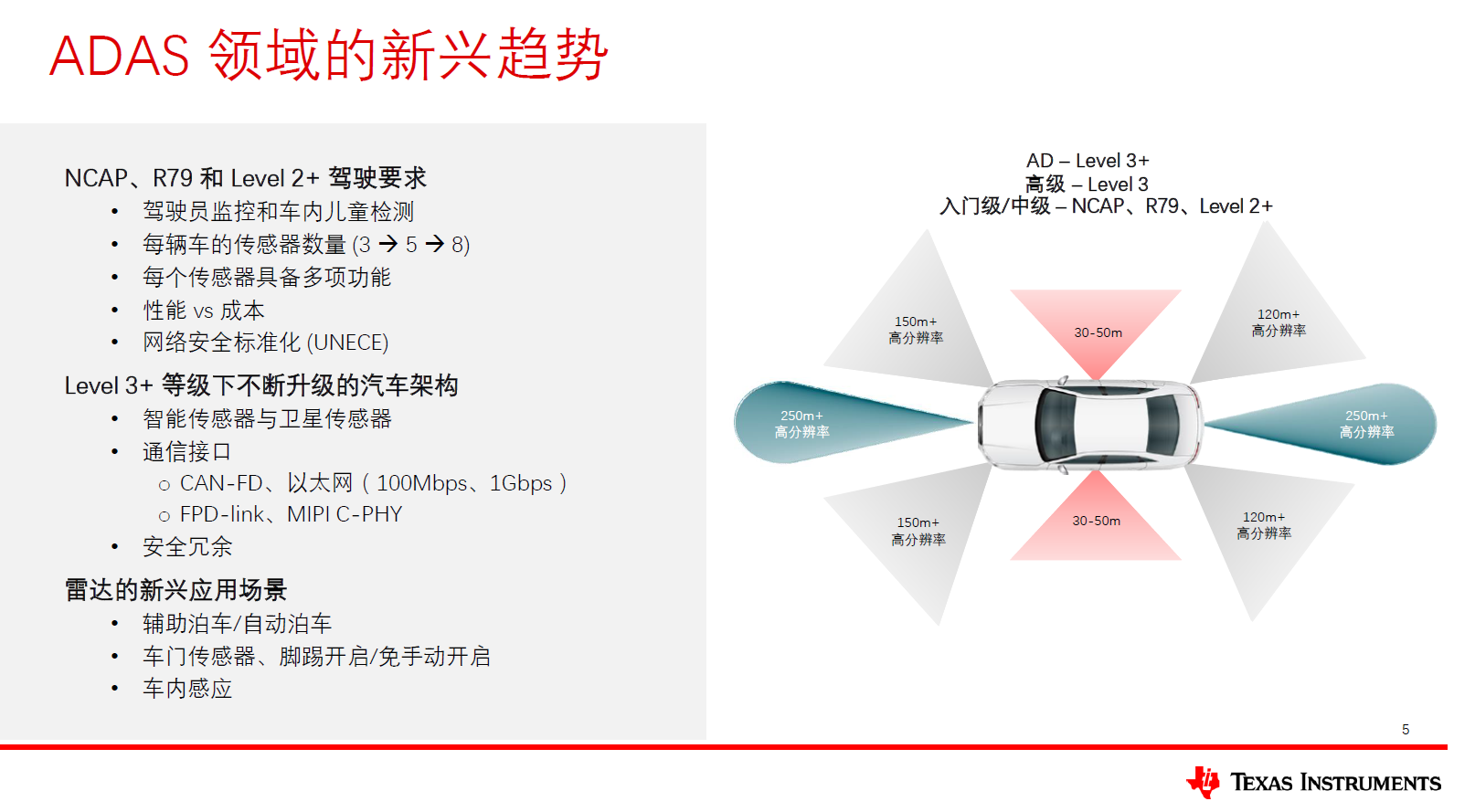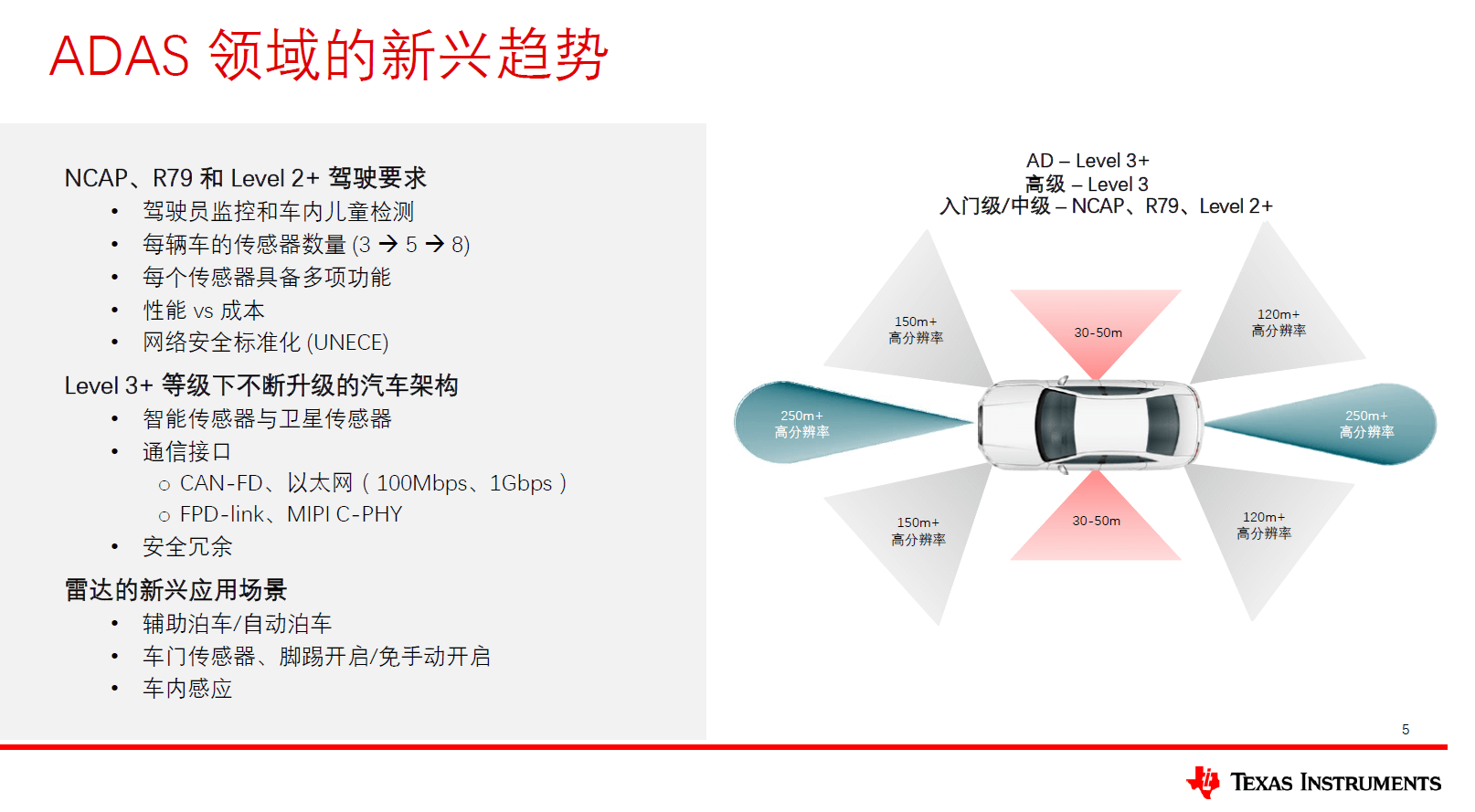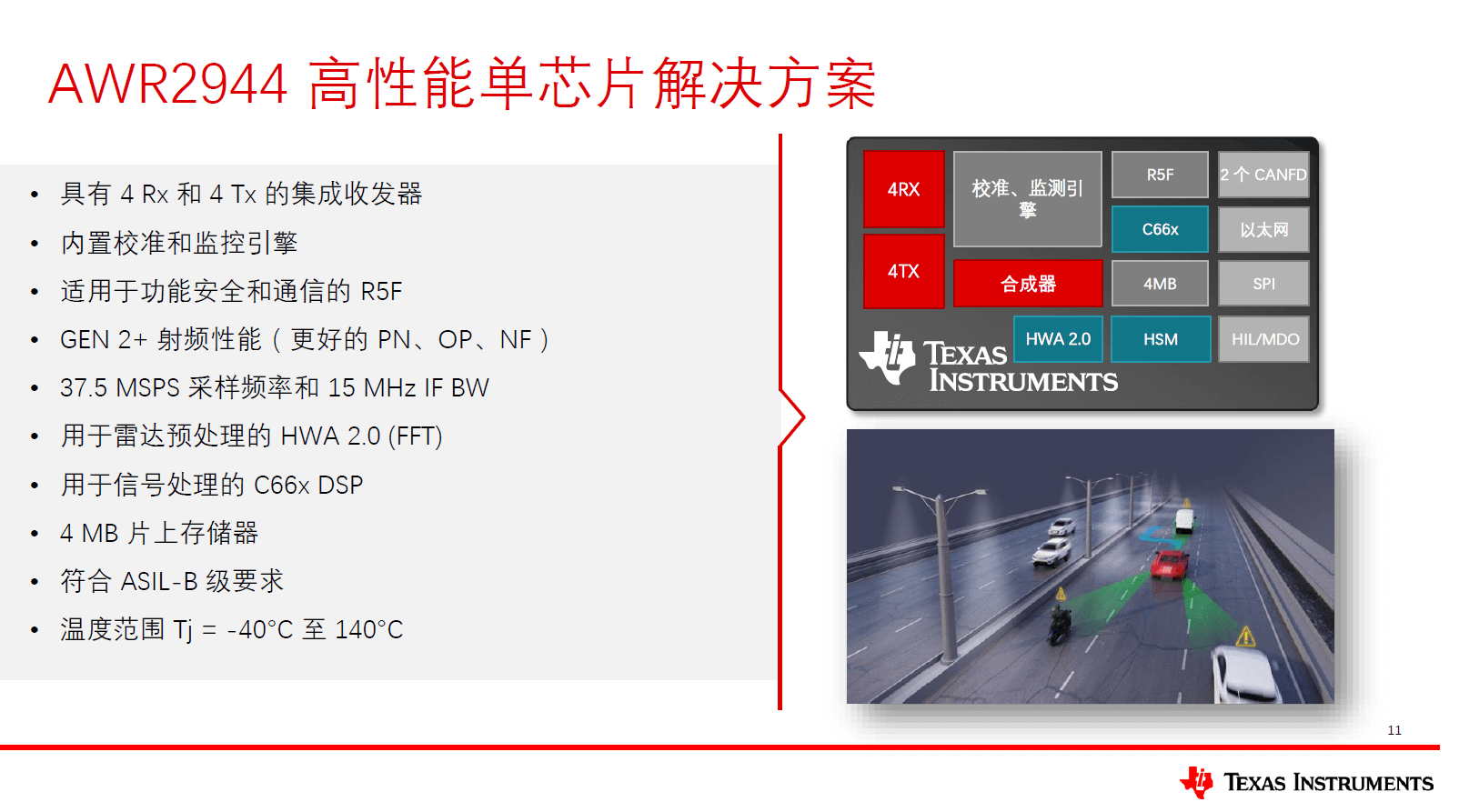Millimeter wave radar is becoming one of the core sensors of ADAS because it can penetrate dust/rain/snow, is not affected by bad weather, and can work around the clock. According to the data of a third-party market survey agency, the market size of China's vehicle mounted millimeter wave radar will reach 3.6 billion yuan in 2020. It is estimated that in the next few years, China's vehicle mounted millimeter wave radar will grow rapidly at a 40% growth rate.
Recently, the spokesman of Texas Instruments (TI) shared the latest product AWR2944 millimeter wave radar chip in the ADAS field to the media such as International Electronic Business Information. This is TI's second generation millimeter wave radar single chip with a working frequency band of 77GHz, which is suitable for adaptive cruise, automatic emergency braking, forward collision warning and other scenarios.
Future of vehicle mounted millimeter wave radar
The working band of millimeter wave radar is generally 30GHz - 300GHz, and the wavelength is between microwave and centimeter wave (1mm-10mm). It has the advantages of both microwave radar and photoelectric radar. In terms of application frequency band, there are mainly two types of mature commercial vehicle mounted millimeter wave radars: 24GHz (MRR, short and medium range radar) and 77GHz (LRR, long range radar). Among them, the detection range of the 24GHz MRR is within 70 meters, which is suitable for blind spot monitoring (BSD), lane change assistance, adaptive cruise (ACC), automatic emergency braking (AEB) and other scenarios; The 77GHz LRR detection range is hundreds of meters, mainly used in adaptive cruise, automatic emergency braking, forward collision warning (FCW) and other scenarios.
In essence, there is little difference between a 24GHz product and a 77GHz product, but the latter is considered to be the mainstream of the future automotive millimeter wave radar because of its small size, low power consumption, high bandwidth, good resolution and long detection distance. At present, domestic vehicle mounted millimeter wave radar products are mainly in the 24GHz band, and their supply chain has been relatively mature, with a market share of more than 50%.
The reporter of International E-Commerce noted that on December 6, 2021, the Ministry of Industry and Information Technology issued the Interim Provisions on the Administration of Automotive Radar Radio, which clearly stated that 'in order to promote the application of automotive intelligent technology and industrial development, the 76GHz - 79GHz frequency band is planned to be used for automotive radar'. The regulation also states that, from the official implementation of March 1, 2022, 'the application for type approval of radio transmitting equipment of 24.25GHz - 26.65GHz automotive radar will not be accepted and approved'. This means that the 77GHz vehicle mounted millimeter wave radar in China's automobile market can be expected in the future!
In addition, according to the data of a third-party market survey agency, the market size of China's vehicle mounted millimeter wave radar will reach 3.6 billion yuan in 2020. It is estimated that in the next few years, China's vehicle mounted millimeter wave radar will grow rapidly at a 40% growth rate. However, domestic millimeter wave radars in China have a large replacement space, and the market share is mainly occupied by international manufacturers. Currently, domestic millimeter wave radars account for 20% - 30% of the market share. For international millimeter wave radar suppliers, China is a market with great potential.
TI can provide a full set of ADAS solutions
As mentioned above, attracted by the excellent market prospect, international millimeter wave radar participants pay more attention to the Chinese market, and TI is one of them. Recently, TI launched the millimeter wave radar chip AWR2944 to the Chinese market, which is a new second-generation millimeter wave radar single chip. According to Cai Zheng, General Manager of China Automotive Business Department of Texas Instruments, this is a 77GHz millimeter wave radar chip. During operation, signals can be output from the chip, and then returned to the processor through high-speed signal link solutions.

'2021 is regarded as the first year of China's automobile automation. Many vehicle manufacturers have introduced automatic driving/auxiliary driving models, and a hundred schools of thought contend and a hundred flowers bloom in the market.' Cai Zheng explained that the development trend of ADAS is dominated by three major directions: first, relevant regulations, including the New Car Assessment Procedure (NCAP), UN Regulation No. 79, etc; Second, automobile architecture. A good architecture can shorten the time for new cars to come into the market and save costs for automobile enterprises; The third is the application of emerging sensing technologies, including the commercial use of 60GHz/77GHz millimeter wave radar in driving fatigue detection system (DMS) and automatic parking scene.
以The following information can highlight the importance of automatic driving and auxiliary driving:
According to the 2018 Global Road Safety Status Report released by the World Health Organization, the number of deaths caused by traffic accidents in the world each year has reached 1.35 million;
The Federal Highway Administration (FHWA) estimates that more than 50% of traffic casualties occur at intersections or nearby areas;
The latest census data of China shows that by 2020, there are 91 cities with a population of more than 5 million, and China has the largest number of cities with a population of one million;
The United Nations Regulation No. 79 specifies the new motor vehicle safety requirements and new car evaluation procedure (NCAP) standards - automobile manufacturers must improve their ADAS steering system to achieve the function of supporting intelligent assistance and automatic driving.
In this regard, Cai Zheng emphasized that 'TI has been working in the field of automatic driving and auxiliary driving for more than ten years. Its products cover all fields of automatic driving and can help customers and Tier 1 manufacturers quickly design products that meet the requirements of laws and regulations and their own systems.' It is understood that there are three types of products related to the ADAS system launched by TI: first, perception, including millimeter wave radar products, which can digitize the information about the conditions outside the vehicle and the drivers inside the vehicle, and transmit this information to the processor in the system. The second is processing. TI has accumulated more than 10 years of experience in automotive processors, and has experienced the iteration of TDA2x, TDA4x and other products. The third is communication. The improvement of perception ability has increased the requirement for data throughput. The information collected by the sensor end (camera, millimeter wave radar) is transmitted to the processor through the high-speed signal link. TI can provide serial adding/de serial products to meet the data throughput requirements of the auto drive system.
TI can also provide a complete set of power management solutions for power supply systems for automotive camera and radar applications. The AWR2944 has been updated in terms of equipment safety and power management: in terms of equipment safety, the AWR2944 has built-in functional safety modules, built-in R5F, special memory, input/output interfaces and some code hardware. In terms of power management, the single chip scheme based on AWR2944 integrates RF and RAM control. The data exchange efficiency of RF and RAM is very high, so it has a good performance in the overall energy consumption ratio.
Performance Advantages of AWR2944 Single Chip Solution
The auto drive system can be divided into three parts: first, sensing, using radar and sensor technology to sense the conditions of the road outside the vehicle; The second is decision-making. The processor analyzes the data to provide control strategies for the decision-making mechanism of automatic driving; The third is control, which controls the whole car body through the main engine to avoid risks. With the continuous improvement of auto drive system functions, it also puts forward higher requirements for perception accuracy. Cai Zheng revealed that this is one of the reasons why TI developed AWR2944.
About the performance and parameters of AWR2944, Jiang Hong, Director of Embedded Product System and Application of Texas Instruments China, made a detailed introduction: 'We launched the second generation of previous chip AWR2243 in December 2020. After customer evaluation, testing and adoption, AWR2243 was highly praised. Now, we have launched the second generation of single chip AWR2944, which meets AEC-Q100 certification and ASIL-B standards. Compared with the previous generation of products, it has been upgraded in many aspects.'
According to Jiang Hong, the size of AWR2944 radar system has been reduced by 30%; AWR2944 supports 4 transmitters and 4 receivers, and its resolution is improved compared with AWR2243; The RF comprehensive performance of AWR2944 is 50% higher than that of AWR2243; The AWR2944 has built-in hardware acceleration units such as DDMA and C-PHY, which can increase the radar detection range by 40%; The AWR2944 also adds memory, upgrades the processor core, and can be built with more advanced algorithms to upgrade the performance of the customer's angle radar and forward radar.
Now some car enterprises have used AWR2944 in angle radar and forward radar of L2 and L2+systems to adapt to blind spot monitoring system (BSD) and automatic emergency braking system (AEB) applications. Since AWR2944 supports 4 transmitters and 4 receivers, it can accurately detect forward targets when FOV (angle of view) converges, so it can also be used as a forward radar. Of course, if the car system is upgraded to L3 and L4, AWR2944 can also be used as a millimeter wave sensor with other radars. In addition, AWR2944 can also meet the application in the cockpit. At present, TI's 60GHz millimeter wave radar products focus on intelligent cockpit scenes, which can realize the application of driver's sign detection and gesture recognition.

Because the 77GHz millimeter wave radar is small in size, its circuit board area is very small, which makes it difficult to submit the design of radar RF circuit, and the yield of finished products is low. As mentioned above, the AWR2944 radar system has reduced its size by 30%, increased its resolution by 33%, and increased its detection range by 40%. How does TI solve the problem of RF circuit design and yield?
Jiang Hong replied that RF lines and yield are actually considered in many aspects. Antenna design is a very professional field. It involves not only theoretical issues, but also circuit simulation testing, materials, technology, board making and other aspects. All these require very professional technical accumulation. It is gratifying that the entire industrial ecology is making rapid progress in this regard.
Back to TI itself, TI can help customers solve RF circuit design problems. Because there are many self calibration modules in TI chips, for example, the on-board radar has strict requirements on the working temperature, and the car may run outdoors at temperatures below - 20 ℃ or above 60 ℃. In view of the strict working temperature requirements, TI's IC has a lot of on-chip/on-chip/open-loop self calibration. Many links can be linked to each other to ensure the stability of the product, which can also improve the yield of terminal products.
TI Planning for Automobile and Millimeter Wave Radar
From ADAS to automatic driving, from L1-L5, laws and regulations should be in advance, and the development of sensors should also comply with the corresponding laws and regulations. While autonomous vehicle put forward high requirements for perception, they also put forward the requirements of 'all-weather work', 'longer detection distance' and 'more/more accurate perception information dimension' for sensors. In addition, the trend of intelligence and sensor fusion has also emerged in the automotive field.
Jiang Hong believes that the actual needs of customers also play a crucial role in the development of sensors. 'Vehicles with ADAS function will generally be equipped with 5R1V (5 millimeter wave radars and 1 visual sensor), and 8R (8 millimeter wave radars) may be configured in the future, even with higher requirements. The support of many radars and sensors also urges vehicle manufacturers to consider the cost performance issue.
Cai Zheng said that TI's macro direction will never change. First of all, TI has a wide range of product lines in the automotive field. Up to now, there are nearly 8000 automotive products, and hundreds of new products will be launched every year. This is something TI will always adhere to. Secondly, TI announced its capacity expansion plan in 2021, which will ensure the supply of TI automotive chips. Thirdly, due to the rapid expansion of China's emerging markets, TI will keep in touch with the top Tier 1 manufacturers. 'Building a new architecture in central gateway, automatic driving and other fields is the direction for us to cooperate with domestic car manufacturers. In addition, we also see the demand for upgrading in car communication, which puts forward strict requirements for the throughput capacity of communication rate and the effectiveness of transmission efficiency. TI enhances its support for relevant markets through the release of new products.' Finally, the trend of intelligence brings new opportunities, For example, intelligent LED headlights not only have lighting functions, but also have human-computer interaction functions. TI is also discussing and planning relevant leading equipment and innovative applications with head customers.
Since 2021, the forward radar in the Chinese market has grown very fast. Many consulting companies predict that China will become the world's largest forward radar market by 2023. Many customers of TI have started to build two cascaded and four cascaded 4D imaging radars based on AWR2243 chips. This kind of radar maintains the accuracy of millimeter wave range and velocity measurement, and also greatly improves the angle resolution.
In addition, there will be many applications for data fusion in camera and millimeter wave, from traditional post fusion and result fusion to hybrid fusion and front fusion. TI has added high-speed input/output interface in the second generation millimeter wave radar, of which AWR2243 has been mass produced and AWR2944 has been officially launched. Jiang Hong revealed that AWR294x is a family, and more versions with different configurations will be introduced in the future. 'Later, we will launch several more cost-effective products, which is also one of our planned roadmaps. TI is also planning the third generation millimeter wave radar. With the development progress, we will share more new products with you in the future.'